17.1: The Romanesque Period
- Page ID
- 53046
\( \newcommand{\vecs}[1]{\overset { \scriptstyle \rightharpoonup} {\mathbf{#1}} } \)
\( \newcommand{\vecd}[1]{\overset{-\!-\!\rightharpoonup}{\vphantom{a}\smash {#1}}} \)
\( \newcommand{\dsum}{\displaystyle\sum\limits} \)
\( \newcommand{\dint}{\displaystyle\int\limits} \)
\( \newcommand{\dlim}{\displaystyle\lim\limits} \)
\( \newcommand{\id}{\mathrm{id}}\) \( \newcommand{\Span}{\mathrm{span}}\)
( \newcommand{\kernel}{\mathrm{null}\,}\) \( \newcommand{\range}{\mathrm{range}\,}\)
\( \newcommand{\RealPart}{\mathrm{Re}}\) \( \newcommand{\ImaginaryPart}{\mathrm{Im}}\)
\( \newcommand{\Argument}{\mathrm{Arg}}\) \( \newcommand{\norm}[1]{\| #1 \|}\)
\( \newcommand{\inner}[2]{\langle #1, #2 \rangle}\)
\( \newcommand{\Span}{\mathrm{span}}\)
\( \newcommand{\id}{\mathrm{id}}\)
\( \newcommand{\Span}{\mathrm{span}}\)
\( \newcommand{\kernel}{\mathrm{null}\,}\)
\( \newcommand{\range}{\mathrm{range}\,}\)
\( \newcommand{\RealPart}{\mathrm{Re}}\)
\( \newcommand{\ImaginaryPart}{\mathrm{Im}}\)
\( \newcommand{\Argument}{\mathrm{Arg}}\)
\( \newcommand{\norm}[1]{\| #1 \|}\)
\( \newcommand{\inner}[2]{\langle #1, #2 \rangle}\)
\( \newcommand{\Span}{\mathrm{span}}\) \( \newcommand{\AA}{\unicode[.8,0]{x212B}}\)
\( \newcommand{\vectorA}[1]{\vec{#1}} % arrow\)
\( \newcommand{\vectorAt}[1]{\vec{\text{#1}}} % arrow\)
\( \newcommand{\vectorB}[1]{\overset { \scriptstyle \rightharpoonup} {\mathbf{#1}} } \)
\( \newcommand{\vectorC}[1]{\textbf{#1}} \)
\( \newcommand{\vectorD}[1]{\overrightarrow{#1}} \)
\( \newcommand{\vectorDt}[1]{\overrightarrow{\text{#1}}} \)
\( \newcommand{\vectE}[1]{\overset{-\!-\!\rightharpoonup}{\vphantom{a}\smash{\mathbf {#1}}}} \)
\( \newcommand{\vecs}[1]{\overset { \scriptstyle \rightharpoonup} {\mathbf{#1}} } \)
\( \newcommand{\vecd}[1]{\overset{-\!-\!\rightharpoonup}{\vphantom{a}\smash {#1}}} \)
\(\newcommand{\avec}{\mathbf a}\) \(\newcommand{\bvec}{\mathbf b}\) \(\newcommand{\cvec}{\mathbf c}\) \(\newcommand{\dvec}{\mathbf d}\) \(\newcommand{\dtil}{\widetilde{\mathbf d}}\) \(\newcommand{\evec}{\mathbf e}\) \(\newcommand{\fvec}{\mathbf f}\) \(\newcommand{\nvec}{\mathbf n}\) \(\newcommand{\pvec}{\mathbf p}\) \(\newcommand{\qvec}{\mathbf q}\) \(\newcommand{\svec}{\mathbf s}\) \(\newcommand{\tvec}{\mathbf t}\) \(\newcommand{\uvec}{\mathbf u}\) \(\newcommand{\vvec}{\mathbf v}\) \(\newcommand{\wvec}{\mathbf w}\) \(\newcommand{\xvec}{\mathbf x}\) \(\newcommand{\yvec}{\mathbf y}\) \(\newcommand{\zvec}{\mathbf z}\) \(\newcommand{\rvec}{\mathbf r}\) \(\newcommand{\mvec}{\mathbf m}\) \(\newcommand{\zerovec}{\mathbf 0}\) \(\newcommand{\onevec}{\mathbf 1}\) \(\newcommand{\real}{\mathbb R}\) \(\newcommand{\twovec}[2]{\left[\begin{array}{r}#1 \\ #2 \end{array}\right]}\) \(\newcommand{\ctwovec}[2]{\left[\begin{array}{c}#1 \\ #2 \end{array}\right]}\) \(\newcommand{\threevec}[3]{\left[\begin{array}{r}#1 \\ #2 \\ #3 \end{array}\right]}\) \(\newcommand{\cthreevec}[3]{\left[\begin{array}{c}#1 \\ #2 \\ #3 \end{array}\right]}\) \(\newcommand{\fourvec}[4]{\left[\begin{array}{r}#1 \\ #2 \\ #3 \\ #4 \end{array}\right]}\) \(\newcommand{\cfourvec}[4]{\left[\begin{array}{c}#1 \\ #2 \\ #3 \\ #4 \end{array}\right]}\) \(\newcommand{\fivevec}[5]{\left[\begin{array}{r}#1 \\ #2 \\ #3 \\ #4 \\ #5 \\ \end{array}\right]}\) \(\newcommand{\cfivevec}[5]{\left[\begin{array}{c}#1 \\ #2 \\ #3 \\ #4 \\ #5 \\ \end{array}\right]}\) \(\newcommand{\mattwo}[4]{\left[\begin{array}{rr}#1 \amp #2 \\ #3 \amp #4 \\ \end{array}\right]}\) \(\newcommand{\laspan}[1]{\text{Span}\{#1\}}\) \(\newcommand{\bcal}{\cal B}\) \(\newcommand{\ccal}{\cal C}\) \(\newcommand{\scal}{\cal S}\) \(\newcommand{\wcal}{\cal W}\) \(\newcommand{\ecal}{\cal E}\) \(\newcommand{\coords}[2]{\left\{#1\right\}_{#2}}\) \(\newcommand{\gray}[1]{\color{gray}{#1}}\) \(\newcommand{\lgray}[1]{\color{lightgray}{#1}}\) \(\newcommand{\rank}{\operatorname{rank}}\) \(\newcommand{\row}{\text{Row}}\) \(\newcommand{\col}{\text{Col}}\) \(\renewcommand{\row}{\text{Row}}\) \(\newcommand{\nul}{\text{Nul}}\) \(\newcommand{\var}{\text{Var}}\) \(\newcommand{\corr}{\text{corr}}\) \(\newcommand{\len}[1]{\left|#1\right|}\) \(\newcommand{\bbar}{\overline{\bvec}}\) \(\newcommand{\bhat}{\widehat{\bvec}}\) \(\newcommand{\bperp}{\bvec^\perp}\) \(\newcommand{\xhat}{\widehat{\xvec}}\) \(\newcommand{\vhat}{\widehat{\vvec}}\) \(\newcommand{\uhat}{\widehat{\uvec}}\) \(\newcommand{\what}{\widehat{\wvec}}\) \(\newcommand{\Sighat}{\widehat{\Sigma}}\) \(\newcommand{\lt}{<}\) \(\newcommand{\gt}{>}\) \(\newcommand{\amp}{&}\) \(\definecolor{fillinmathshade}{gray}{0.9}\)The Romanesque Period
Romanesque art was affected by shifting political powers following the Carolingian period and mobility during the Crusades.
Summarize the economics and politics of the Romanesque Period
Key Points
- The invasion of England by William Duke of Normandy in 1066 led to the construction of castles and churches to reinforce the Norman presence. Several significant churches built at this time were founded as seats of temporal and religious power or places of coronation and burial.
- The Crusades (1095–1270) brought about extensive migration and resultant spread of ideas and trade skills.
- The continual movement of people, rulers, nobles, bishops, abbots, craftsmen and peasants was an important factor in creating homogenous building methods and a recognizable Romanesque style , despite regional differences.
- The period saw Europe grow steadily more prosperous, and art of the highest quality was no longer confined to the royal court and a small circle of monasteries. Lay artists became increasingly valuable, and this category included most masons, goldsmiths, and painters by the end of the period.
Key Terms
- lay: Not belonging to the clergy, but associated with them.
- Crusade: One of a series of ostensibly religious campaigns by Christian forces from the 11th to the 13th century, mostly to capture the Holy Land from the Muslims who occupied it.
- feudalism: A social system based on personal ownership of resources and fealty between a suzerain (lord) and a vassal (subject). Defining characteristics are direct ownership of resources, personal loyalty, and a hierarchical social structure reinforced by religion.
The Source of Inspiration
Romanesque architecture was the first distinctive style to spread across Europe after the collapse of the Roman Empire. Despite the misconception of 19th century art historians that Romanesque architecture was a continuation of Roman styles, Roman brick and stone building techniques were lost in most parts of Europe. In the northern countries Roman style and methods were only adopted for official buildings, and in Scandinavia they were unknown. The exception was several great Constantinian basilicas that continued to stand in Rome as an inspiration to later builders. However, these did not inspire the Emperor Charlemagne’s Palatine Chapel in Aachen, Germany, built around the year AD 800. Instead, the greatest building of the Dark Ages in Europe was the artistic child of the octagonal Byzantine Basilica of San Vitale in Ravenna, built in the sixth century.
A New European Empire
Charlemagne was crowned by the Pope in St. Peter’s Basilica on Christmas Day in 800 CE, with an aim of reestablishing the old Roman Empire. Charlemagne’s political successors continued to rule much of Europe, leading to the gradual emergence of the separate political states that were eventually welded into nations by allegiance or defeat. In the process, the Kingdom of Germany gave rise to the Holy Roman Empire. The invasion of England by William Duke of Normandy, in 1066 saw the building of castles and churches that reinforced the Norman presence. Several significant churches built at this time were founded by rulers as seats of temporal and religious power or as places of coronation and burial. These include the Abbaye-Saint-Denis and Westminster Abbey (where little of the Norman church now remains).
The remaining architectural structures of the Roman Empire were falling into decay and much of its technology was lost. At the same time, however, the building of masonry domes and carving of decorative architectural details continued unabated, though the style had greatly evolved since the fall of Rome in the enduring Byzantine Empire. The domed churches of Constantinople and Eastern Europe had a substantial influence on the architecture of certain towns, particularly through trade and the Crusades. The most notable example is St Mark’s Basilica, Venice , but there are many lesser known examples such as the church of Saint Front, Périgueux and Angoulême Cathedral .
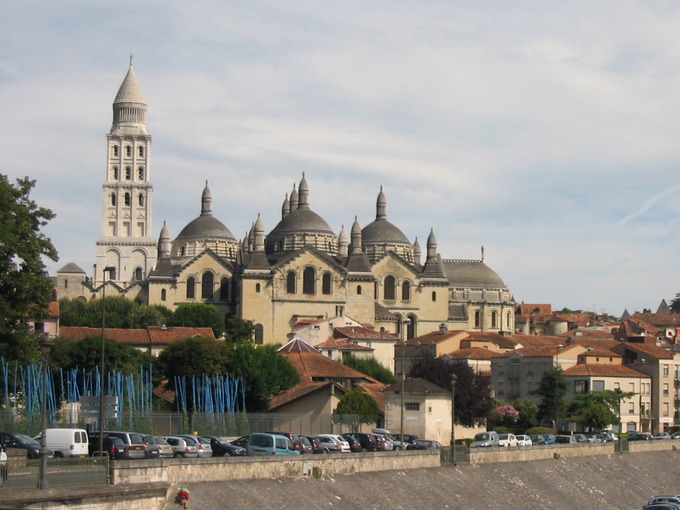
Feudalism and Warfare
Much of Europe was affected by feudalism, in which peasants held tenure from local rulers over the land they farmed in exchange for military service. As a result, they could be called on for local spats as well as to follow their lord across Europe to the Crusades.
The Crusades (1095–1270) brought about substantial migration and resultant spread of ideas and trade skills, particularly the building of fortifications and the metalworking for the provision of arms, which was also applied to the fitting and decoration of buildings. The continual movement of people, rulers, nobles, bishops, abbots, craftsmen, and peasants was an important factor in creating homogeneous building methods and a recognizable Romanesque style, despite regional differences.
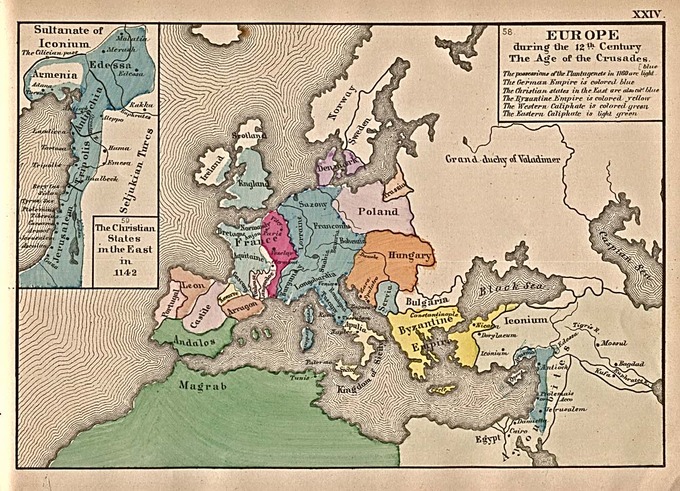
Life became less secure after the Carolingian period, resulting in castles built at strategic points. Many were constructed as strongholds of the Normans, descendants of the Vikings who invaded northern France in 911. Political struggles also resulted in the fortification of towns by rebuilding and strengthening walls that remained from the Roman period. One of the most notable surviving fortifications is that of the city of Carcassonne. The enclosure of towns resulted in a style of tall, narrow townhouse with limited living space . These often surrounded communal courtyards, as at San Gimignano in Tuscany.
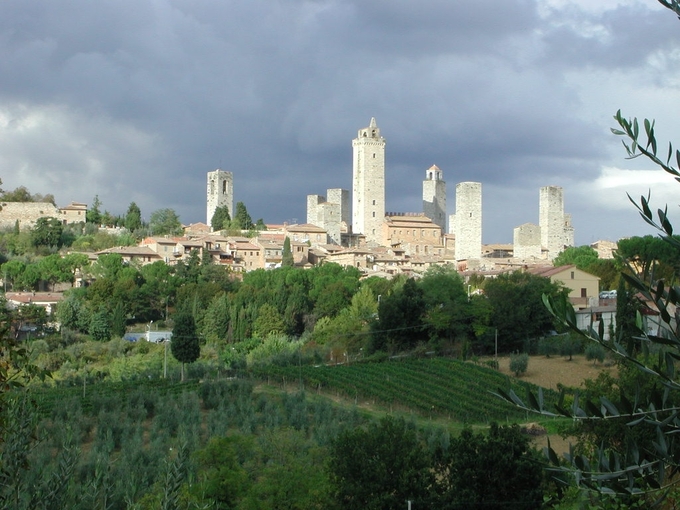
Growing Prosperity
As Europe grew steadily more prosperous during this period, art of the highest quality was no longer confined to the royal court and a small circle of monasteries as in the Carolingian and Ottonian periods. Monasteries remained important, especially those of the new Cistercian , Cluniac , and Carthusian orders that spread across Europe. City churches, including those on pilgrimage routes and many in small towns and villages, were elaborately decorated. Indeed, these have often survived when cathedrals and city churches have been rebuilt, while Romanesque royal palaces have not. The lay artist, Nicholas of Verdun, became a valued figure known across the continent. Most masons and goldsmiths were now lay professionals rather than monastic clergy, and lay painters like Master Hugo were the majority by the end of the period. The iconography of their church work was likely determined in consultation with clerical advisers.
Romanesque Art
Romanesque art refers to the art of Europe from the late 10th century to the rise of the Gothic style in the 13th century.
Evaluate Romanesque architecture, sculpture, and painting
Key Points
- The Romanesque style was the first to spread across the whole of Catholic Europe and thus the first pan-European style since Imperial Roman Architecture.
- Combining features of Roman and Byzantine buildings and other local traditions, Romanesque architecture exhibits massive quality, thick walls, round arches , sturdy piers , groin vaults , large towers, and symmetrical plans.
- The art of the period was characterized by a vigorous style in both painting and sculpture.
- Colors, which we can now see in their original brightness only in stained glass and well-preserved manuscripts, tended to be very striking.
- The tympanums of important church portals were carved with monumental schemes, often depicting iconography from Byzantine painting.
Key Terms
- groin vault: The intersection at right angles of two barrel vaults.
- tympanum: A triangular space between the sides of a pediment; the space within an arch and above a lintel or a subordinate arch, spanning the opening below the arch.
- pier: In architecture, an upright support for a structure or superstructure such as an arch or bridge.
Romanesque art refers to the art of Europe from the late 10th century to the rise of the Gothic style in the 13th century or later, depending on region. The term “Romanesque” was invented by 19th century art historians to refer specifically to architecture of the time period, which retained many basic features of Roman architectural style—most notably semi-circular arches—but retained distinctive regional characteristics. In Southern France, Spain, and Italy, there was architectural continuity with the Late Antique period, but the Romanesque style was the first style to spread across the whole of Catholic Europe and thus the first pan-European style since Imperial Roman Architecture. Romanesque art was also influenced by Byzantine art, especially in painting, and by the anti-classical energy of the decoration of the Insular art of the British Isles. From these elements was forged a highly innovative and coherent style.
Architecture
Combining features of Roman and Byzantine buildings along with other local traditions, Romanesque architecture is distinguished by massive quality, thick walls, round arches, sturdy piers, groin vaults, large towers, and decorative arcades . Each building has clearly defined forms and a symmetrical plan, resulting in a much simpler appearance than the Gothic buildings that would follow. The style can be identified across Europe, despite regional characteristics and materials.
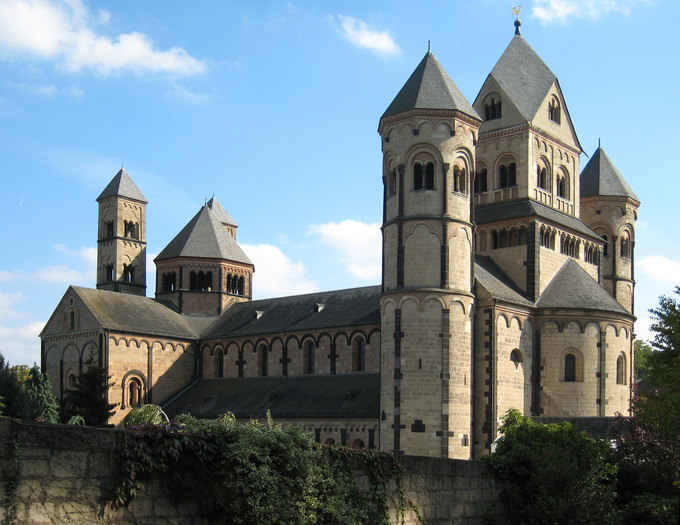
Painting
Aside from architecture, the art of the period was characterized by a vigorous style in both painting and sculpture. In churches, painting continued to follow Byzantine iconographic models. Christ in Majesty, the Last Judgement and scenes from the Life of Christ remained among the most common depictions. In illuminated manuscripts , the most lavishly decorated examples of the period included bibles or psalters . As new scenes were depicted, more originality developed. They used intensely saturated primary colors , which now exist in their original brightness only in stained glass and well-preserved manuscripts. Stained glass first came to wide use during this period, although there are few surviving examples.
Pictorial compositions usually had little depth as they were limited to the narrow spaces of historiated initials, column capitals , and church tympanums. The tension between a tight frame and a composition that sometimes escapes its designated space is a recurrent theme in Romanesque art. Figures often varied in size in relation to their importance, and landscape backgrounds were absent or closer to abstract decorations than realism , as in the trees in the “Morgan Leaf.” Human forms were often elongated and contorted to fit the shape provided and at times appeared to be floating in space. These figures focused on linear details with emphasis on drapery folds and hair.
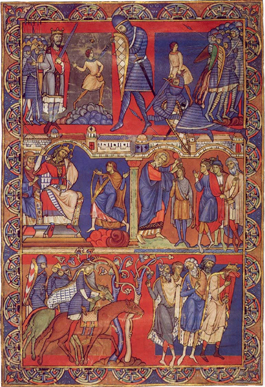
Sculpture
Sculpture also exhibited a vigorous style, evident in the carved capitals of columns, which often depicted complete scenes consisting of several figures. Precious objects sculpted in metal, enamel , and ivory , such as reliquaries , also had high status in this period. While the large wooden crucifix and statues of the enthroned Madonna were German innovations at the start of the period, the high relief carvings of architectural elements are most evocative of this style.
In a significant innovation, the tympanums of important church portals were carved with monumental schemes, again depicting Christ in Majesty or the Last Judgement but treated with more freedom than in painted versions. These portal sculptures were meant to both intimidate and educate the viewer . As there were no equivalent Byzantine models, Romanesque sculptors felt free to expand in their treatment of tympanums.
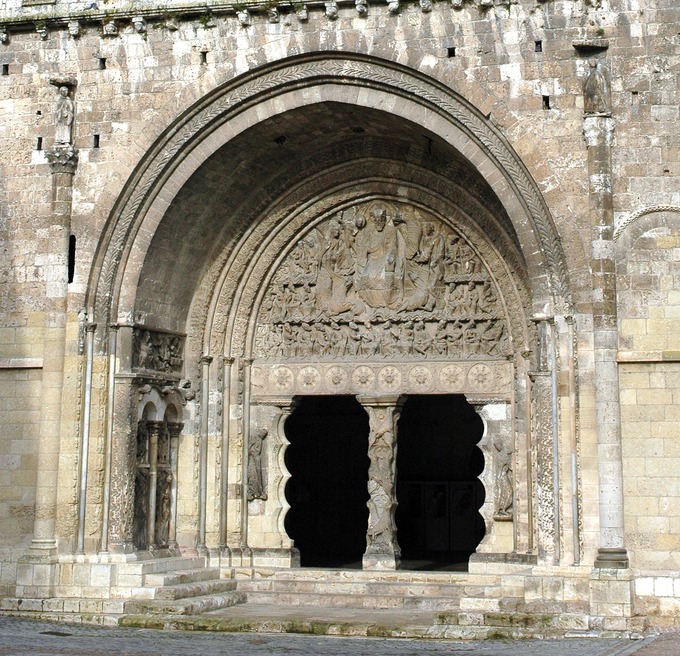
- Curation and Revision. Provided by: Boundless.com. License: CC BY-SA: Attribution-ShareAlike
- San Gimignano. Provided by: Wikipedia. Located at: en.Wikipedia.org/wiki/File:San_Gimignano.JPG. License: CC BY-SA: Attribution-ShareAlike
- Pu00e9rigueux 3. Provided by: Wikipedia. Located at: en.Wikipedia.org/wiki/File:P%C3%A9rigueux_3.JPG. License: Public Domain: No Known Copyright
- Europe 1142. Provided by: Wikipedia. Located at: en.Wikipedia.org/wiki/File:Europe_1142.jpg. License: Public Domain: No Known Copyright
- Romanesque architecture. Provided by: Wikipedia. Located at: en.Wikipedia.org/wiki/Romanesque_architecture%23Portals. License: CC BY-SA: Attribution-ShareAlike
- Romanesque art. Provided by: Wikipedia. Located at: en.Wikipedia.org/wiki/Romanesque_art. License: CC BY-SA: Attribution-ShareAlike
- Crusade. Provided by: Wiktionary. Located at: en.wiktionary.org/wiki/Crusade. License: CC BY-SA: Attribution-ShareAlike
- feudalism. Provided by: Wiktionary. Located at: en.wiktionary.org/wiki/feudalism. License: CC BY-SA: Attribution-ShareAlike
- lay. Provided by: Wiktionary. Located at: en.wiktionary.org/wiki/lay. License: CC BY-SA: Attribution-ShareAlike
- Portal moissac. Provided by: Wikipedia. Located at: en.Wikipedia.org/wiki/File:Portal_moissac.jpg. License: CC BY-SA: Attribution-ShareAlike
- MorganLeafVerso. Provided by: Wikipedia. Located at: en.Wikipedia.org/wiki/File:MorganLeafVerso.jpg. License: Public Domain: No Known Copyright
- Maria Lach 02. Provided by: Wikipedia. Located at: en.Wikipedia.org/wiki/File:Maria_Lach_02.jpg. License: CC BY-SA: Attribution-ShareAlike
- Romanesque art. Provided by: Wikipedia. Located at: en.Wikipedia.org/wiki/Romanesque_art. License: CC BY-SA: Attribution-ShareAlike
- Romanesque architecture. Provided by: Wikipedia. Located at: en.Wikipedia.org/wiki/Romanesque_architecture. License: CC BY-SA: Attribution-ShareAlike
- groin vault. Provided by: Wikipedia. Located at: en.Wikipedia.org/wiki/groin%20vault. License: CC BY-SA: Attribution-ShareAlike
- Boundless. Provided by: Boundless Learning. Located at: www.boundless.com//biology/definition/tympanum. License: CC BY-SA: Attribution-ShareAlike
- pier. Provided by: Wikipedia. Located at: en.Wikipedia.org/wiki/pier. License: CC BY-SA: Attribution-ShareAlike


